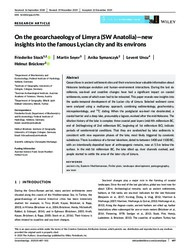On the geoarchaeology of Limyra (SW Anatolia)—new insights into the famous Lycian city and its environs
DOI: https://doi.org/10.1002/gea.21781
Persistent URL: http://resolver.sub.uni-goettingen.de/purl?gldocs-11858/9232
Persistent URL: http://resolver.sub.uni-goettingen.de/purl?gldocs-11858/9232
Stock, Friederike; Seyer, Martin; Symanczyk, Anika; Uncu, Levent; Brückner, Helmut, 2020: On the geoarchaeology of Limyra (SW Anatolia)—new insights into the famous Lycian city and its environs. In: Geoarchaeology, Band 35, 4: 487 - 502, DOI: 10.1002/gea.21781.
 |
Dokument öffnen: |
Geoarchives in ancient settlement sites and their environs bear valuable information about Holocene landscape evolution and human–environment interactions. During the last six millennia, sea-level and coastline changes have had a significant impact on coastal settlements, some of which even had to be relocated. This paper reveals new insights into the spatio-temporal development of the Lycian city of Limyra. Selected sediment cores were analyzed using a multiproxy approach, combining sedimentology, geochemistry, micropaleontology, and 14C dating. When the postglacial sea-level rise decelerated, a coastal barrier and a deep lake, presumably a lagoon, evolved after the mid-Holocene. The siltation history of the lake is complex: three coastal peat layers (mid-4th millennium BC, end of 3rd/beginning of 2nd millennium BC, beginning of 1st millennium BC), indicate periods of semiterrestrial conditions. That they are sandwiched by lake sediments is consistent with new expansion phases of the lake, most likely triggered by coseismic subsidence. There is evidence of a former lakeshore, dated to between 1400 and 1100 BC, with an intentionally deposited layer of anthropogenic remains, now at 5.5 m below the surface. In the mid-1st millennium BC, the lake silted up, river channels evolved, and people started to settle the area of the later city of Limyra.
Statistik:
ZugriffsstatistikSammlung:
- Geographie, Hydrologie [453]
Schlagworte:
ancient cityEastern Mediterranean
Finike plain
landscape development
paleogeography
sea level
This is an open access article under the terms of the Creative Commons Attribution License, which permits use, distribution and reproduction in any medium, provided the original work is properly cited.

